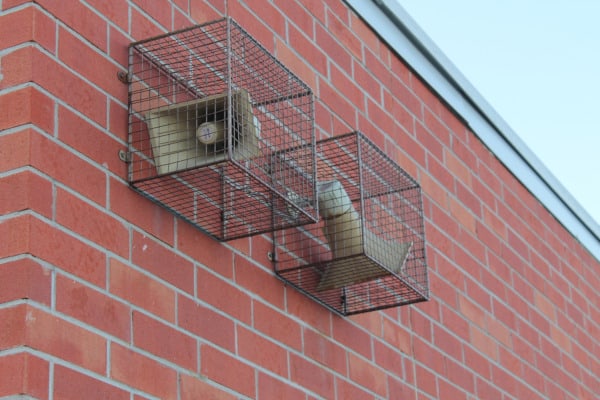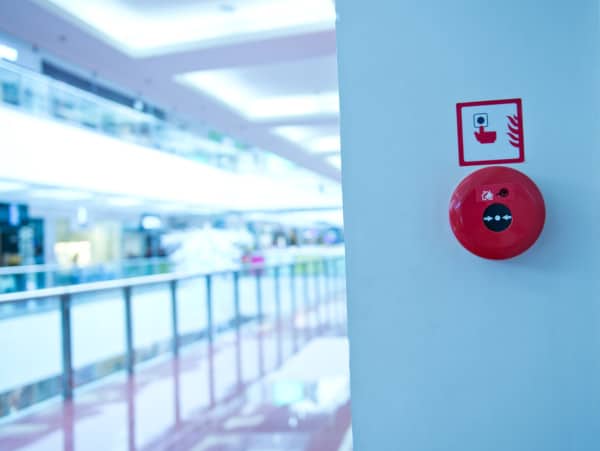Fire alarm requirements for educational, detention, assembly, business, mercantile, storage, and industrial occupancies
In the first installment of this series, we talked about the various ways of accomplishing the initiation, occupant notification, and monitoring of a fire alarm system. In this piece, we cover how NFPA 101: Life Safety Code specifically requires the following occupancies to perform those functions:
- Educational occupancies
- Detention and correctional occupancies
- Assembly occupancies
- Business and mercantile occupancies
- Storage and industrial occupancies
Stay tuned for Part 3, where we’ll cover these requirements for one- and two-family dwellings, hotels and dormitories, apartments, residential board and care facilities, inpatient and outpatient healthcare, and daycare occupancies.
In the meantime, this article serves as a basis for understanding pretty dense code and, as such, requires a lot of references. To get the most out of the read, we suggest cozying up with your copy of NFPA 101 to follow along!
What is my building’s occupancy type?
If you’re not sure which occupancy type your building falls under, refer to this article or NFPA 101, section 6.1 for guidance. Beyond a clear definition, multiple types of occupancies can also coexist in an overall structure; either together in the same space, or next to one another and separated. The code offers different ways to address this. Some occupancies are considered an “incidental occupancy” to the predominant occupancy, and they can be treated as part of that larger occupancy. An example of this is a small mercantile gift shop in a hotel.
For scenarios involving the coexistence of larger occupancies, the code has two general approaches. Section 6.1.14.3 allows for a “mixed occupancy” approach, where the most restrictive requirements of the occupancies involved are typically applied to all of them. Last, there is a “separated occupancy” (6.1.14.4). In this scenario, each occupancy is separated by fire barriers, resulting in distinctly separate spaces with different alarm requirements.
NFPA 101 also distinguishes between new and existing structures and applies different mandates for each of them, though these rules can overlap.
Fire alarm requirements for educational and detention and correctional occupancies
Educational and detention and correctional occupancies have similar requirements for alarms and their monitoring. NFPA 101 states that a facility where six or more people up to grade 12 receive instruction for four or more hours a day is considered an educational occupancy (6.1.3.1). A facility housing at least one person under restraint is a detention and correctional occupancy (6.1.7.1).
Educational occupancies
For both new and existing educational occupancies, NFPA 101 requires fire alarm systems (14.3.4.1.1 and 15.3.4.1.1). Some exceptions can be applied, such as in 14.3.4.1.2 and 15.3.4.1.2, for smaller, single-classroom buildings.
Initiation and Occupant Notification
Alarms should initiate by manual fire alarm boxes – commonly called pull stations (14.3.4.2.1 and 15.3.4.2.1) but the code allows for the exclusion of manual boxes in some spaces (such as laboratories and cafeterias) serviced by an automatic sprinkler system or other detection devices (14.3.4.2.3.1 and 15.3.4.2.3.1).
If the building is protected throughout with an approved sprinkler system, NFPA 101 allows for the exclusion of manual boxes as long as a provision is made to activate the fire alarm system at a central point (14.3.4.2.3.2 and 15.3.4.2.3.2). When provided, an automatic fire sprinkler system that activates must also activate the fire alarm system (14.3.4.2.2 and 15.3.4.2.2).
Existing educational occupancies may also forgo manual alarm boxes in classrooms where a two-way PA system is available to notify an on-site, constantly supervised location that can contact emergency forces. New facilities don’t get this provision.
From the 2018 edition of NFPA 101
15.3.4.2.1(2) In buildings where all normally occupied spaces are provided with a two-way communication system between such spaces and a constantly attended receiving station from where a general evacuation alarm can be sounded, the manual fire alarm boxes shall not be required, except in locations specifically designated by the authority having jurisdiction.
Overall, occupant notification “shall be accomplished automatically in accordance with 9.6.3” and “shall utilize an emergency voice/alarm communication system in accordance with 9.6.3 where the building has an occupant load of more than 100” (14.3.4.3.1.1 and 14.3.4.3.1.2). For more detail on what “in accordance with 9.6.3” means, check out that section NFPA 101 and/or review part one in this series.
Educational occupancies may also use a positive alarm sequence (outlined in section 9.6.3.4), which allows for a slight delay between alarm initiation and occupant notification.
Monitoring
New educational facilities must always employ fire alarm monitoring in accordance with 9.6.4 (14.3.4.3.2). Existing facilities may continue to call emergency forces on their own until it comes time to replace their fire alarm system, at which point they must install a means for monitoring and automatic emergency forces notification that complies with Section 9.6.4 (15.3.4.3.2).

Detention and correctional occupancies
Initiation
Sections 22.3.4.2 and 23.3.4.2 of NFPA 101 require fire alarms to initiate manually, as well as by any detection devices that may be required in other parts of the code. But just like pulling the fire alarm may be done to get kids out of class, a pull station might look like a “get out of jail free” card to an inmate. As with fire sprinklers in these facilities, special precautions must be taken to prevent tampering. That’s why NFPA 101 allows detention and correctional facilities to lock these pull stations up, provided certain conditions are met.
From the 2018 edition of NFPA 101
23.3.4.2 Initiation. Initiation of the required fire alarm system shall be by manual means in accordance with 9.6.2 and by means of any required detection devices or detection systems, unless otherwise permitted by the following:
(1) Manual fire alarm boxes shall be permitted to be locked, provided that staff is present within the area when it is occupied and staff has keys readily available to unlock the boxes.
(2) Manual fire alarm boxes shall be permitted to be located in a staff location, provided that both of the following criteria are met:
(a) The staff location is attended when the building is occupied.
(b) The staff attendant has direct supervision of the sleeping area.
Occupant notification
If you were locked in a cell and couldn’t go anywhere when a fire alarm went off, that would be a pretty terrible experience. Sections 22.3.4.3.1(2) and 23.3.4.3.1(2) try to limit this panic by allowing all detention and correctional occupancies to configure their smoke detectors to alarm only at an on-site, constantly supervised location in situations where alarming the entire facility is impractical. Otherwise, these occupancies follow section 9.6.3 for occupant notification.
Monitoring
NFPA 101 requires detention and correctional occupancies to have their fire alarms monitored in accordance with Section 9.6.4 (22.3.4.3.2.1 and 23.3.4.3.2.1). There are, however, a few exceptions detailed in sections 22.3.4.3.2.1(1-3) and 23.3.4.2.1(1-3). Where the system employs a positive alarm sequence or staff who can promptly notify the fire department to monitor the alarm system, no other monitoring is required. Smoke detectors are also not required to automatically notify the fire department (22.3.4.3.2.1(1-3) and 23.3.4.3.2.1(2)).

Fire alarms in assembly occupancies
Assembly occupancies are those where 50 or more people gather for deliberation, worship, entertainment, eating, drinking, amusement, awaiting transportation, or similar uses (6.1.2.1). Fire alarm requirements kick in when these structures exceed an occupant load of 300 people.
Initiation
Alarms must usually trigger manually, though manual initiation isn’t necessary if the system meets a couple of criteria:
From the 2018 edition of NFPA 101
12.3.4.2.1 Initiation of the required fire alarm system shall be by both of the following means:
(1) Manual means in accordance with 9.6.2.1(1), unless otherwise permitted by one of the following:
(a) The requirement of 12.3.4.2.1(1) shall not apply where initiation is by means of an approved automatic fire detection system in accordance with 9.6.2.1(2) that provides fire detection throughout the building.
(b) The requirement of 12.3.4.2.1(1) shall not apply where initiation is by means of an approved automatic sprinkler system in accordance with 9.6.2.1(3) that provides fire detection and protection throughout the building.
The same requirement applies to both new assembly occupancies and existing assembly occupancies (13.3.4.2.1). Any required automatic sprinkler systems should also initiate the alarm, even in areas where pull stations are already provided (12.3.4.2.1(2) and 13.3.4.2.1 (2)).
But this is where assembly occupancies get a little different than other types. While everyone else in the building is watching a movie, having a town hall meeting, or gathering for whatever reason, there has to be someone manning a receiving station where the alarm must send a signal whenever it’s initiated (12.3.4.2.2 and 13.3.4.2.2). If the occupant load is over 300, there must also be automatic detection in all hazardous areas where people don’t normally go unless there are already automatic sprinklers there (12.3.4.2.3 and 13.3.4.2.3).
Occupant notification
As for occupant notification, that’s up to the person attending the alarm. When the person in the constantly attended location sees that the alarm has been triggered – and it shouldn’t be hard to notice because section 12.3.4.3 requires both audible and visible alarms – the person must initiate a voice announcement to the whole building (12.3.4.3.3 and 13.3.4.3.3). If it’s a new structure, the individual also has to also initiate visible signals (12.3.4.3.4).
Monitoring
Clearly, these facilities can monitor their own alarms. But if an authority having jurisdiction (AHJ) deems it impractical for a new assembly occupancy to accommodate such a receiving station, the facility can employ both of the measures described below:
From the 2018 edition of NFPA 101
12.3.4.3.7 Where the authority having jurisdiction determines that a constantly attended receiving station is impractical, both of the following shall be provided:
(1) Automatically transmitted evacuation or relocation instructions shall be provided in accordance with NFPA 72.
(2) The system shall be monitored by a supervising station in accordance with NFPA 72.
Existing assembly occupancies may omit the monitoring by a supervising station and implement only a voice announcement if the AHJ determines a receiving station to be impractical (13.3.4.3.7).

Mercantile and business occupancies: Fire alarm requirements
Buildings that store and display merchandise (mercantile occupancies) and those used for all other types of transactions (business occupancies) have very similar requirements for their fire alarm systems in NFPA 101.
According to sections 36.3.4.1 and 37.3.4.1, all Class A mercantile facilities (defined by section 36.1.2.2.1 as those with more than three stories or 30,000 square feet of sales space) need fire alarm systems.
In contrast, new business occupancies only need a fire alarm system if they meet one of the following criteria in section 38.3.4.1:
- Three or more stories,
- More than 50 occupants above or below the discharge level, or
- 300 or more total occupants.
For existing businesses, the thresholds are higher:
- Three or more stories
- 100 or more occupants over the discharge level, or
- 1,000 or more total occupants.
What’s the discharge level? Succinctly, the main exit from which most people (not less than half) in the building will leave it. Less succinctly …
From the 2018 edition of NFPA 101
3.3.88.1* Level of Exit Discharge. The story that is either (1) the lowest story from which not less than 50 percent of the required number of exits and not less than 50 percent of the required egress capacity from such a story discharge directly outside at the finished ground level; or (2) where no story meets the conditions of item (1), the story that is provided with one or more exits that discharge directly to the outside to the finished ground level via the smallest elevation change.
Initiation
NFPA 101 allows any mercantile or business occupancies that need an alarm system to take their pick between different methods of initiation – manually, or by automatic detectors or sprinkler systems (36.3.4.2, 37.3.4.2, 38.3.4.2, and 39.3.4.2). In each of these cases, at least one pull station must be installed even where there are automatic detection or sprinkler systems (9.6.2.6).
Occupant notification
Whichever initiation system they use, the fire alarms in new business and mercantile occupancies must notify occupants automatically, as specified in section 9.6.3 (36.3.4.3.1 and 38.3.4.3.1). These may also use a positive alarm sequence (outlined in section 9.6.3.4), which allows for a slight delay between alarm initiation and occupant notification.
NFPA 101 places the same requirements on existing business and mercantile occupancies but also gives them the option of instead using a voice announcement to alert occupants (37.3.4.3.1 and 39.3.4.3.1). If these existing occupancies opt to perform occupant notification in accordance with 9.6.3, they may use the presignal system described below:
From the 2018 edition of NFPA 101
9.6.3.3 Where permitted by Chapters 11 through 43, a presignal system shall be permitted where the initial fire alarm signal is automatically transmitted without delay to a municipal fire department, to a fire brigade (if provided), and to an on-site staff person trained to respond to a fire emergency.
A presignal system sends the alarm only to a supervising station where it is processed and, if determined to be legitimate, activated to alert the entire building (NFPA 72: 23.8.1.1).
Monitoring
NFPA 101 mandates that all mercantile and new business occupancies must have fire alarm monitoring that complies with Section 9.6.4 (36.3.4.3.2, 37.3.4.3.2, and 38.3.4.4). Existing business occupancies may wait until it’s time to replace their fire alarm to equip themselves with monitoring (39.3.4.4).
Industrial and storage occupancies
Buildings where products or material are manufactured (industrial occupancies) or where products, materials or vehicles are stored (storage occupancies) need alarm systems if they meet certain size or hazard levels (NFPA 101, 6.1.12.1 and 6.1.13.1). This part of the code actually does not distinguish between new and existing structures, so requirements here apply for both unless otherwise noted.
All industrial facilities with 100 or more total occupants and more than 25 people above or below the level of exit discharge to have a fire alarm system (40.3.4.1). According to Section 42.3.4.1, all storage facilities must have an alarm system unless they:
- Contain low-hazard contents (defined by section 6.2 as those non-combustible enough that they couldn’t self-propagate a fire)
- Contain ordinary to high-hazard contents (those that are, at most, likely to burn rapidly or cause explosions) making up under 100,000 square feet of space
- Use an automatic sprinkler system
Initiation
Industrial or storage facilities that do need an alarm may pick between those that are initiated manually or by automatic sprinklers or other detection devices (40.3.4.2 and 42.3.4.2). No matter which option you choose, you must always have at least one manual alarm box in the building (40.3.4.2(2-3) and 42.3.4.2(2-3)).
Occupant notification
NFPA 101 gives two options for occupant notification: notify occupants in accordance with Section 9.6.3, or have the alarm initiate both audible and visible signals at a constantly attended location (40.3.4.3 and 42.3.4.3). If the facility contains high hazard industrial materials or storage contents, occupant notification must include an evacuation signal (40.3.4.3.4 and 42.3.4.3.4).
Monitoring
NFPA 101 does not require monitoring for either storage or industrial occupancies, but that doesn’t mean that you shouldn’t play it safe and defend your property even when it’s unoccupied. And though monitoring is not mandated, a signal at a “constantly attended location” is required for fire alarm systems in these occupancy types at all times when the building is occupied. Again, this should be a person who is located where they can respond to a signal – such as a guard tower, security console, etc. – and trained to initiate emergency action.
Satisfy your fire alarm requirements
It’s important to make sure your building satisfies the code for its unique occupancy type in order to ensure safety and avoid costly code violation fines. If you think your building’s fire alarm system may be lacking necessary features, remedy it immediately.
Stay tuned for part three of this series, where we’ll explain the fire alarm requirements for one- and two-family dwellings, lodging and rooming houses, hotels and dorms, apartments, residential board and care facilities, inpatient and outpatient healthcare facilities, and day care centers.
QRFS offers a selection of fire protection equipment, fire alarm bells, and fire alarm testing equipment. Viking pull stations manufactured by Potter Electric Signal Company are also available for pre-order at QRFS; simply contact us at (888) 361-6662 or email support@qrfs.com.




Very good and concise information. Very helpful.
Thank you
Very helpful information, thanks,
Do three stories in a business occupancy include a cellar that has only utilities and no place of assembly or commerce
Anil — For code questions like this, you can try our Ask a Fire Pro service. Click the link to submit your question with some information about your building, and a fire protection professional will provide an answer based on best practices, standards, and codes. Our pros include AHJs, contractors, engineers, and code experts with 150+ years of combined experience!
A building that already has a pre existing sprinkler and alarm system. That is one story, and has seperated suites within. Can a new buisness rip out the pre existing alarm, audible and visual systems?
Johnny – We’re unsure why you would want to rip out the system unless it is outdated and you are upgrading it. But if you’d like a code interpretation of the requirements for your specific building, you can provide details (such as occupancy type and square footage) and try our Ask a Fire Pro service. Click the link to submit your question with some information about your building, and a fire protection professional will provide an answer based on best practices, standards, and codes. Our pros include AHJs, contractors, engineers, and code experts with 150+ years of combined experience!
Does a Municipal Garage require horn strobes and visuals? We will be extending the fire alarm system out from the main building to the garage. Adding a nac panel in garage to accommodate. The owner wants to be notified in an event of a fire back from the main family panel.
Dale – For specific code questions like this, you can try our Ask a Fire Pro service. Click the link to submit your question with some information about your building, and a fire protection professional will provide an answer based on best practices, standards, and codes. Our pros include AHJs, contractors, engineers, and code experts with 150+ years of combined experience!
If you have a residential floor on the third floor and offices on the second floor, and merchantile on the GF:
Question:.
Do I need to put Fire Alarm in all floors? Or there is an exception for the residential floor.
Thank you very much!
Sarah – For mixed-use code questions like this, you can try our Ask a Fire Pro service. Click the link to submit your question with some information about your building, and a fire protection professional will provide an answer based on best practices, standards, and codes. Our pros include AHJs, contractors, engineers, and code experts with 150+ years of combined experience!
Does my company need to have an fire alarm system? We manufacture liquid asphalt so we have over 20,000 gallons of diesel fuel in underground storage tanks. We have a sprinkler system, but no pull boxes or loud speaker that would reach all the different buildings on the premise. Is it a law to have a warning system of some kind to alert all employees of a potential safety hazard?
M — For code questions like this, you can try our Ask a Fire Pro service. Click the link to submit your question with some information about your building and system, and a fire protection professional will provide an answer based on best practices, standards, and codes. Our pros include AHJs, contractors, engineers, and code experts with 150+ years of combined experience!
Question on elements requiring supervisory – we have a restaurant, 1 story, <100 person occupancy, 2 hour fire wall to the space next door in a strip mall. With these metrics I don’t believe a system is required.
The kitchen has a hood with Ansul system, and 2 AHU’s over 2000 CFM. This tells me a system is required. Any insight would be appreciated
Morgan — For system and code questions like this, you can try our Ask a Fire Pro service. Click the link to submit your question with some information about your building and system, and a fire protection professional will provide an answer based on best practices, standards, and codes. Our pros include AHJs, contractors, engineers, and code experts with 150+ years of combined experience!
Hello, I am curious to know the notification requirements for a “training”/ classroom located in a “B” occupancy? does the training/classroom need a horn strobe in it or can the notification device in the main entry of the “B” occupancy the only notification device required.
Rick — We can’t provide a definitive answer, especially without knowing more about your building, area, and which codes are in force in your area (e.g., NFPA 101, the International Fire Code, etc., and what edition). You should consult with a qualified fire protection professional to assess your situation and determine your needs.
But below are some relevant sections from the 2021 edition of NFPA 101 pertaining to occupant notification in a B occupancy, plus a specific classroom reference:
Overall requirements (does it need a system; emphasis added):
38.3.4 Detection, Alarm, and Communications Systems.
38.3.4.1 General. A fire alarm system in accordance with Section 9.6 shall be provided in all business occupancies where any one of the following conditions exists:
(1) The building is three or more stories in height.
(2) The occupancy is subject to 50 or more occupants above or below the level of exit discharge.
(3) The occupancy is subject to 300 or more total occupants.
Occupant notification sections:
38.3.4.3 Occupant Notification.
During all times that the building is occupied (see 7.2.1.1.3), the required fire alarm system, once initiated, shall perform one of the following functions:
(1) It shall activate a general alarm in accordance with 9.6.3.
(2) A positive alarm sequence in accordance with 9.6.3.5 shall be permitted.
A relevant section of 9.6.3, per the above:
9.6.3.6 Unless otherwise provided in 9.6.3.6.1 through 9.6.3.6.8, notification signals for occupants to evacuate shall be by audible and visible signals in accordance with NFPA72 and ICC A117.1, Accessible and Usable Buildings and Facilities, or other means of notification acceptable to the authority having jurisdiction.
The rules in 9.6.3.6.1 through 9.6.3.6.8:
9.6.3.6.1 Areas not subject to occupancy by persons who are hearing impaired shall not be required to comply with the provisions for visible signals.
9.6.3.6.2 Visible-only signals shall be provided where specifically permitted in health care occupancies in accordance with Chapters 18 and 19.
9.6.3.6.3 Existing alarm systems shall not be required to comply with the provision for visible signals.
9.6.3.6.4 Visible signals shall not be required in lodging or rooming houses in accordance with Chapter 26.
9.6.3.6.5 Visible signals shall not be required in exit stair enclosures.
9.6.3.6.6 Visible signals shall not be required in elevator cars.
9.6.3.6.7* Public mode visual notification appliances in accordance with NFPA72 shall not be required in designated areas as permitted by Chapters 11 through 43, provided that they are replaced with approved alternative visible means.
9.6.3.6.8* Where visible signals are not required, as permitted by 9.6.3.6.7, documentation of such omission shall be maintained in accordance with 9.13.3.
Finally, there is a section specifying additional rules for classrooms in B occupancies, though it doesn’t pertain specifically to visible signals:
38.3.4.5* Risk Analysis for Mass Notification.
A risk analysis in accordance with Section 9.14 shall be performed for business occupancies containing a classroom where the building is owned, rented, leased, or operated by a college or university to determine whether a mass notification system is required.
Do you have a place or service or somewhere I can click a link to submit my question with some information about my building and system, and have a fire protection professional provide an answer based on best practices, standards, and codes?
Juergen — We do offer that with our Ask a Fire Pro service. You can learn more and submit a question at that link. Thanks!
, NFPA 72 only mandates the use of low frequency 520 Hz audible alarms, initiated by the building fire alarm system,
in mezzanine
Is smoke detector that puts out sound alert is it an audible device ? Or not the same thing.
If not is fire bell which sounds as a horn an audible device .?
Are fire bell(s) and smoke detectors considered audible devices ? Situated on horizontal service spaces on a mezzanine 10 % in area of an assembly builds ?
Ajit — anything that emits sound in response to an alarm signal/condition is an audible device. The term differentiates this alert from visual alarms, such as strobes.
Hi, here is a laboratory in School and we are facing the problem of False alarm when they perform the experiment in lab, due to the fumes aften smoke detectors are activate and generate the false alarm, could we replace the smoke detector with heat detector in school laboratory.
Joginder — You shouldn’t do it, specifically … but a qualified fire protection technician who evaluates the system requirements and building might be able to do it following code. Thanks for reading.
Can a fire department require an inspection of both smoke and CO detectors and a new HVAC has been installed in an occupied single family dwelling?
Brad — The answer to this question isn’t perfectly clear and boils down to “what do your local laws require?”
As far as model codes that local rules are typically based on, the International Building Code, for example, references NFPA 72 for inspection requirements. The inspection, testing, and maintenance requirements are too lengthy to detail here. However, for CO detectors, for example, NFPA 72 requires at least monthly inspections and following manufacturer instructions for inspecting/testing CO alarms (the individual devices) and more testing and inspection requirements for CO detectors that are part of a full fire/life safety alarm system (You can read more about those requirements for CO detection here).
But the bottom line is to check out your local laws and see if the fire department has that authority for a single-family dwelling. Off the top of our head, it seems unusual unless it is some sort of managed commercial residential property—but that should not be interpreted as any type of formal interpretation. Check your local codes based on the structure!
how was the threshold of 300 established for A occupancy? That is to say, why 300 and not say 250 or 100?
Dan – Its a good question that we don’t have the answer to at the moment; the NFPA 101 committee members at the time would, however. Why they arrived at this specific number may be in the notes during the code design process for that cycle. If we look into it and find the rationale for 300 specifically, we’ll update!